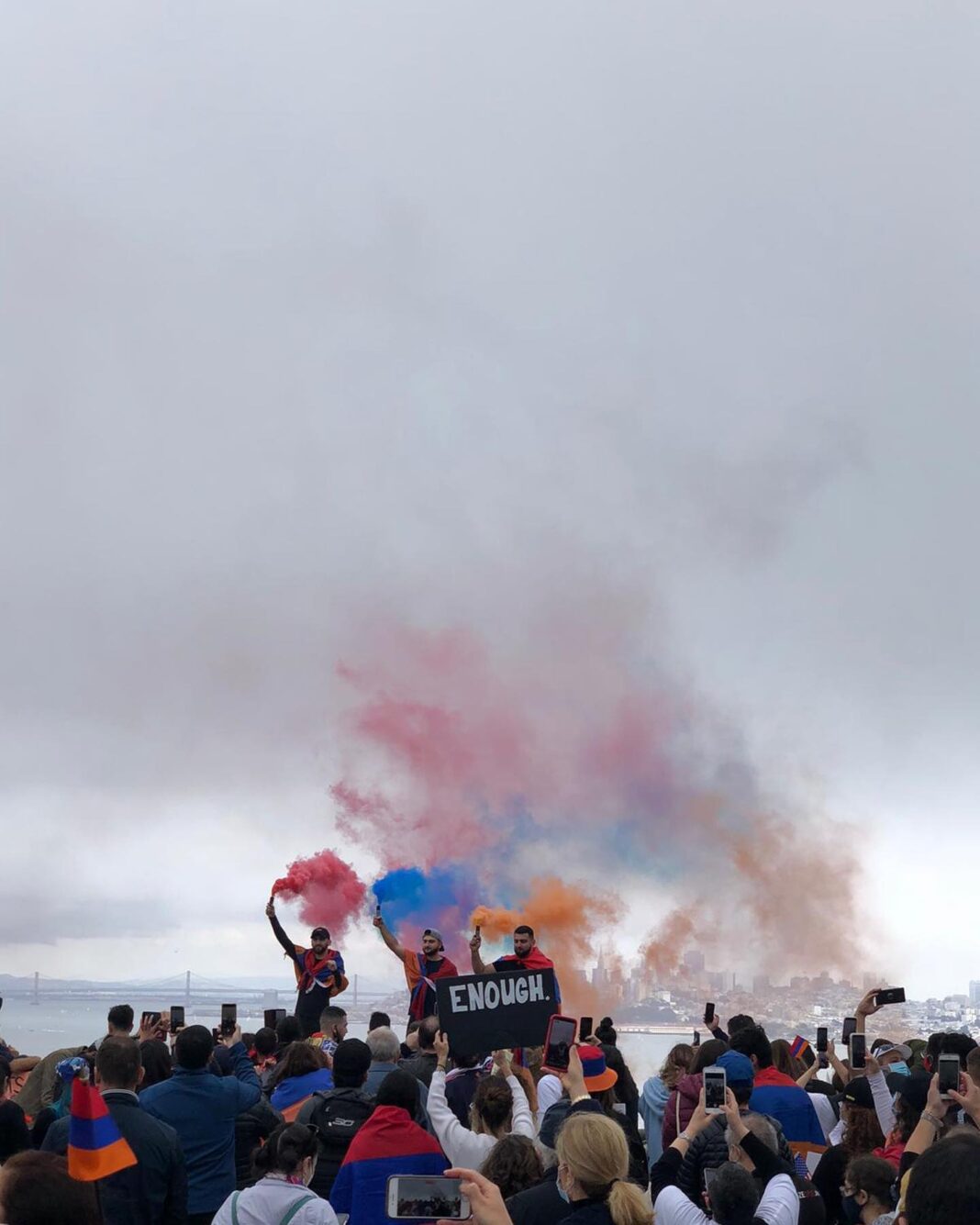SAN FRANCISCO—Armenian and pro-Armenian protesters marched Saturday, October 10, on the Golden Gate Bridge expressing support for Armenia in the nation’s conflict with Azerbaijan over the ethnic-Armenian enclave of Nagorno-Karabakh.
The Armenian Youth Federation organized the protest on Facebook, and titled the event “San Francisco Armenian-American Community Protests Turkey and Azerbaijan’s Aggression Against Armenia.” Hundreds gathered at the Strauss Plaza at roughly 11:30 a.m., and began their march on the Golden Gate Bridge 10 minutes later. According to the Facebook event page, 498 users responded.
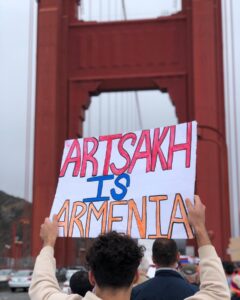
The fight between Armenia and Azerbaijan began on September 27 around the region known to Armenians as Artsakh. On October 9, Azeri news reported 30 civilians were killed during shelling by Armenian forces. According to a PBS NewsHour report by journalist Simon Ostrovsky, as of October 8, 75,000 Armenians fled across the border to the Republic of Armenia. He reported dozens of civilian deaths on their side.
Armenian and Armenian American demonstrators said that Nagorno-Karabakh, or Artsakh, is historically Armenian land that was given to Azerbaijan under Soviet rule in the early 1920s.
The people of Armenia and Azerbaijan were under the rule of the Russian Empire, and its successor state, the Soviet Union. The two nations gained independence in 1991 when the USSR collapsed. Armenia and Azerbaijan went to war over Nagorno-Karabakh, and there has been conflict over the territory since.
Armenian demonstrators said that from their perspective, the conflict is a struggle against military aggression by Azerbaijan in the Armenian “holy land” of Artsakh, which has thousands of years of history.
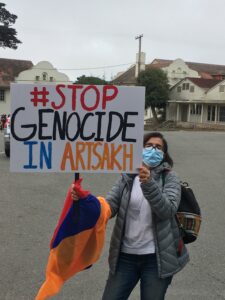
Anahip Parkhayan, a software engineer from Armenia, and her group of friends and family, said they were calling for peace and were seeking to raise awareness about the conflict in their community. They said Nagorno-Karabakh was given to Azerbaijan in 1921. Parkhayan and her group members mentioned the deaths and displacement of Armenians during bombing campaigns by Azeri forces in the current military conflict over the enclave. She said after the collapse of the Soviet Union, the disputed territory held a referendum for independence that Azerbaijan never recognized, and was therefore controlled against the will of the people there.
“We want to make sure our community is aware of our conviction about the oppression. We want to stop the war. Civilians right now are under attack.”
When Parkhayan’s group was asked if they viewed Nagorno-Karabakh as historically Armenian land, one man holding a “Peace for Armenia” sign said that the Soviets “gave it to them [Azerbaijan] in 1921.” Regarding the demographic changes due to Turkish settlement in the region during medieval to modern times, he said the territory was still “95% Armenian.”
Another demonstrator who only wanted to be identified by the nickname “Tate” also said the territory was 95 percent Armenian when it was transferred to Azerbaijani control.
“It is historically Armenian land. During Soviet times, 95% of the population was Armenian,” said Tate. “We are fighting for their right to live in their own land. They are being killed. Innocent civilians are dying. We are here to spread awareness.”
She added, “Azerbaijan just wants the land. It wants the land without Armenians. Its policy is to get rid of the people and populate it with the Azerbaijani people.”
Elly Kapalyan, a fashion designer of Armenian ethnicity, said: “We are being attacked after generations of being attacked and victimized by Turks and Azeris. We need to fight for justice.”
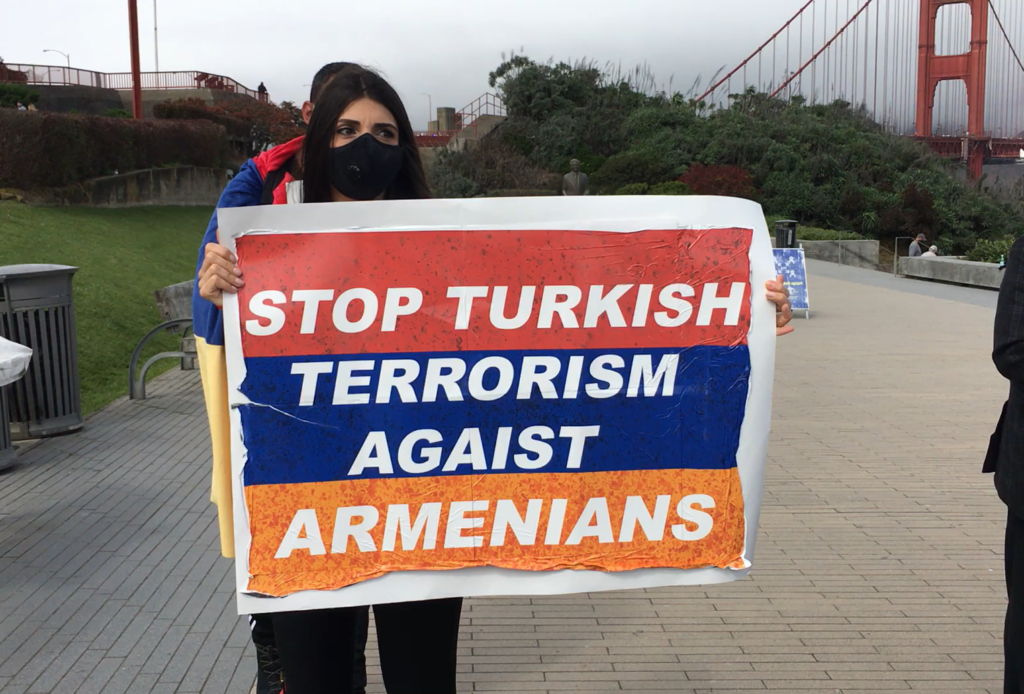
Kapalyan also said that Karabakh was given to the newly established Azerbaijan by Soviet dictator Joseph Stalin.
“We took it back after the Soviet [state] collapsed in the 1990s,” Kapalyan said. “Do you understand how small of a claim they have to the land that we now have to go to war with them, and with Turkey?”
Kapalyan claimed to have ancestors from Karabakh:
“Azerbaijan took Karabakh under their jurisdiction. Prior to that it was always Armenian land. My great-grandmother and great-great-grandmother were all from Artsakh, which is Karabakh. It has been Armenian land for thousands of years, under Armenian and Persian rule, on and off, but that whole area was Armenian only.”
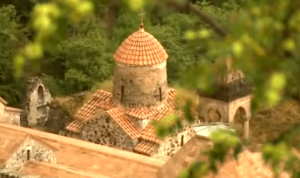
She also mentioned that the territory was never given fully to Azerbaijani jurisdiction because of its historical and cultural importance to Armenians.
“The reason Karabakh was never ever given fully to the control of Azerbaijan was because it is considered our holy land. You understand? That one region of Karabakh is a very sacred region to us as Armenians. Half of the lands that Azerbaijan is under is historically Armenian, going back thousands of years. The other surrounding regions that were also given away—we did not fight as hard for them.”
Kapalyan described what she viewed as a “cultural genocide” by Azeris in Karabakh.
“They have demolished churches and cemeteries. They are destroying our heart. For them, this is just a piece of land. For us, this is part of us,” she said. “They are taking our history away from us. They are demolishing historical churches. Thousands of them have been demolished. They are destroying our culture. It is a cultural genocide. They are destroying our heritage. The reason Karabakh is our heart is because of its huge significance to Armenians.”
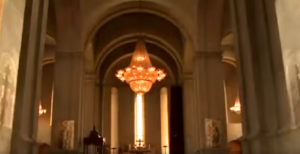
Protest signs mentioned Turkey, which has been supporting Azerbaijan during the conflict. Both nations have a shared history in the Turkish migrations to Western Asia during medieval times.
The Turkish-state funded TRT maintains the narrative that Nagorno-Karabakh was occupied illegally by Armenia since the Nagorno-Karabakh War (1991-1994) in which 30,000 people were killed. “Shame on Turkey” and references to the Armenian 1915 genocide by Ottoman Turkish forces were common themes of protest signs.
In a phone interview, fashion designer Kapalyan gave a summary of her understanding of the history of the Turkish migration to the areas around present-day Armenia, as part of her assertion that the Azeris have “little claim” to Karabakh. She said that Azeris and Turks just showed up.
Kapalyan described the establishment of the Ottoman Empire in this way:
“Throughout 300-400 years the Ottoman Empire, who were barbaric nomads, created their own nation through rape, kidnapping of women, kidnapping of children from tribes after massacring their homes, taking their possessions, and moving forward,” she said.
She also described the history of crimes committed against Armenians by the ancestors of the modern states of Turkey and Azerbaijan.
“They started to claim and oppress all of the nations within the Ottoman Empire. They had mass killings,” Kapalyan added. “The Armenian Genocide did not just happen in 1915. They have massacred Greeks and Armenians in the hundreds of thousands while they were governing that region for three hundred to four hundred years.”
Rose Cholakaian, an accountant, said, “We want peace. That’s our land. It has been occupied by Armenians since before Christ. We want Turkey and Azerbaijan to stop the aggression.”
When asked if she holds the narrative that Karabakh was given to Azerbaijan by Soviet dictator Josef Stalin, she responded:
“Correct. We fought and we want our land back. They are going against a peace treaty that has been in place since the 1990s. Azerbaijan thinks they are above everyone. We want peace and we want our land. That’s it.”
Nagorno-Karabakh is a self-declared independent state known as the Republic of Artsakh. The Armenian enclave has strong ties with the Republic of Armenia. The territory is internationally recognized by the UN as Azerbaijani territory. Cholakaian was referring to the Republic of Artsakh’s referendum on independence that was never recognized by Azerbaijan.
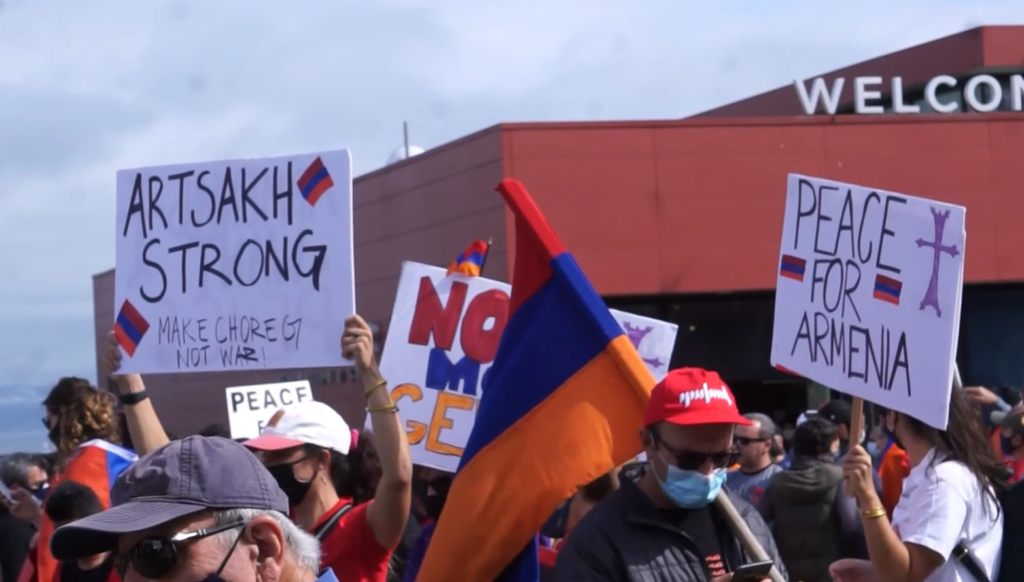
When asked about what it would take for Armenians to get their political goals in Karabakh achieved, Cholakaian referred to the de-facto independence of the Republic of Artsakh and said, “It is currently our land. We have won that land back. It is an independent union, part of Armenia, and it would stay the same as it is.”
Armenian forces are currently in control of Azerbaijani territories outside of Karabakh, as a slice of territory separates Karabakh from the Republic of Armenia.
BBC correspondents Orla Guerin and Steve Rosenberg found “bitterness” and “patriotic fervor” among Azerbaijanis living on the frontlines.
Asef Haqverdiyev said, “I am 51 now, and I am ready to die for my country.”
Haqverdiyev described the sacrifices he was willing to make over the war against Armenia:
“I have sent my own son to the war, and he is fighting at the border. Even if my family dies, even if everyone dies, we are not willing to give one inch of our land.”

